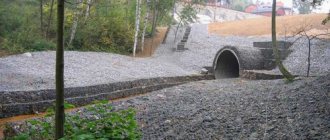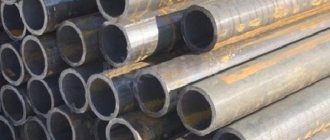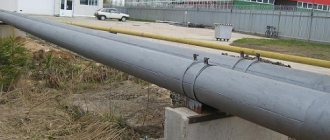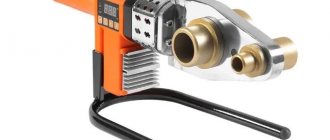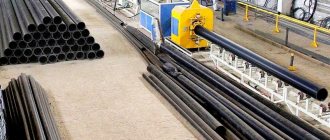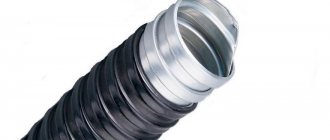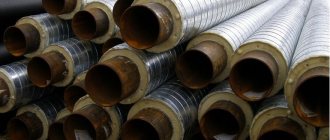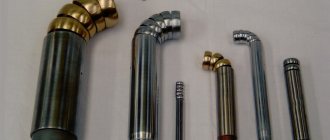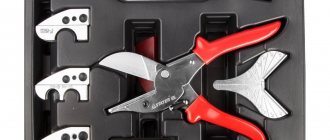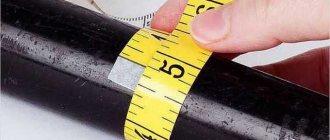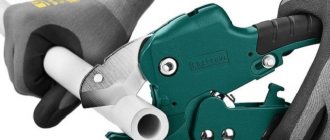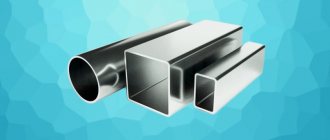Today, flexible thermally insulated pipes from different manufacturers, differing in design and materials used in production, are widely used for laying various pipeline systems. These are Flexalen pipes (produced by the Dutch company Thermaflex), Uponor (the Finnish manufacturer of the same name, formerly called Ecoflex), Microflex (produced by the Belgian company Microflex), as well as Russian manufacturers Polimerteplo (Isoproflex brand) and TVEL (Isopex brand). There are several other manufacturers that occupy a small market share: domestic Izola (Izola-Pro brand) and Izostal (Plastflex brand) and German Rehau (Rauthermex brand).
Each manufacturer offers a whole line of different solutions for cold and hot water supply and heating, so navigating the large number of manufacturers and brands of flexible pre-insulated pipes they produce is far from easy. We will divide this whole mass of brands into main groups.
Cold water supply
Pipes for this purpose are distinguished by the absence of an anti-diffusion protective layer that prevents the penetration of oxygen into the system, since the oxygen content in the cold water supply system has little effect on operational characteristics. At the same time, some brands of pipes are equipped with a heating cable (Flexalen 600 or Uponor Supra Standard), Uponor Supra pipes have a cable duct for installing a heating cable. Some brands of cold water supply pipes are supplied without a heating cable or cable duct. They are designed for laying pipelines at depths below the freezing level. In addition, Flexalen pipes are modified with a thicker thermal insulation, providing increased energy efficiency, and can also be supplied in a two-pipe design, allowing water supply lines to different points to be combined in one heat-insulating casing.
Features of TVEL-PEX
Among the main features of Isopex products, the following should be noted:
- The system is completely isolated. Maximum protection against heat loss is provided through the use of double thermal insulation - semi-rigid polyurethane foam and a LDPE shell.
- Long service life. The estimated service life of TVEL-PEKS heating mains is about 50 years.
- Reliability of the design. Resistance to cracking, provided the carrier temperature is not higher than 95 degrees, makes Isopex pipes reliable and durable.
- No corrosion. Ethyl vinyl hydroxide used in the manufacture of pipes prevents the passage of oxygen, which eliminates the occurrence of corrosion processes.
- Minimum diameter. Due to the lack of roughness of the internal surface, it is possible to use pipes of smaller diameter with the same pipeline capacity.
The use of two- and four-pipe TVEL-PEKS systems ensures a reduction in the volume of excavation work during pipeline installation by up to 40% due to the presence of “forward” and “reverse” flow directions. All TVEL-PEKS products are laid without the use of panel supports and compensators.
Pipes produced by Isopex are easily connected to existing water supply systems. The insulated design is ideal for use in harsh climates.
Simple installation, saving time and money when installing a pipeline, durability, reliability and energy efficiency - these are the advantages of using TVEL-PEKS pipes. You too will appreciate all the advantages of using Isopex insulated systems by placing an order right now by calling the phone number indicated in the header of the site.
Hot water supply
Pipes for hot water supply can also be supplied without an oxygen barrier. They are almost similar to pipes for cold water supply, but are structurally designed without a heating cable, since here the danger of freezing is much lower due to the high water temperature. But energy efficiency is especially important here, so it is much more profitable to use two-pipe systems such as Uponor Varia Twin, Uponor Thermo Twin, Uponor Aqua Twin or two-pipe versions Flexalen 600. There are modifications of pipes with enhanced thermal insulation (Uponor Thermo and Flexalen 600 Premium).
Transportation and storage
Transportation is allowed in any convenient way, subject to the requirements of GOST 26653-90. When choosing the railway method, transportation conditions must comply with GOST 22235-2015. To maintain quality and technical characteristics, it is necessary to comply with the storage conditions in the warehouse after sale, prescribed in GOST 15150. If they are stored in stacks for less than 2 months, their height should not exceed 3 m, if the period is longer - 2 meters. The Technopipe company supplies products throughout Moscow and the region; delivery to other regions of Russia is possible by agreement.
Heating
For heating systems, it is important to have an oxygen anti-diffusion layer that blocks the flow of oxygen into the system, since oxygen causes increased cavitation processes and corrosion of metal elements, as well as the development of aerobic bacteria. Resistance to high temperatures and high pressure is also important. For the installation of heating systems, multi-pipe systems are often used (for example, Uponor Quattro, or Flexalen 1000+). The range of Flexalen pipes is especially wide. In addition, their positive feature is that the material of the main pipe in them is polybutene, which can be welded, which allows the use of not only compression fittings, but also electric welded ones, which do not create a narrowing of the flow section.
Currently, the following manufacturers operate on the Russian market of flexible thermally insulated pipelines:
Advantages of TVEL-PEKS heating mains
The main advantages of Isopex flexible heating mains are:
- Corrosion resistance. The pipes are not subject to corrosion, which guarantees long-term use of heating mains.
- Minimal pressure loss. Due to the lower surface roughness (up to 70 times less compared to conventional PU foam pipes), the PE-Xa working pipe provides less resistance to the medium.
- Minimum connecting connections. Flexible heating mains are produced in long coils, which eliminates a large number of joints during installation.
- Compactness. When compared with PU foam steel products, when using TVEL-PEKS “Isopex” you will need a 40% smaller trench.
- No corner joints. Achieved through minimal bending radii.
This unique system allows you to save on the installation of heating and water supply pipeline networks at any facility.
How to choose the right thermal insulation?
How to choose good thermal insulation panels?
It is best to contact a company that has long established itself in the market as a reliable manufacturer of high-quality heat-insulating materials.
“TEPLOFOM+” is, perhaps, a brand that anyone who wants to insulate a pipeline or sewer can pay attention to.
These panels have 3 qualities that are important in the issue of thermal insulation of water pipes:
- Low thermal conductivity of the system – saving thermal energy.
- High density of the substance - high strength of the panel.
- Duration of use (panels do not need to be changed frequently - this saves time, money and nerves).
Attention!
But you shouldn’t immediately buy insulation from this manufacturer. We took him as an example. Before you make a purchase, compare several suppliers. Here are some criteria that will help in choosing a manufacturer at the initial stage:
- The company's plant producing thermal insulation panels must have the necessary production capacity to produce a product that meets modern international requirements.
- Raw materials are tested in special laboratories by qualified personnel, and imported technological lines eliminate the possibility of defects.
- The authority of the company is confirmed by repeated participation in international exhibitions and honorary awards certifying the quality of the goods produced.
- The company provides the opportunity to manufacture panels according to individual dimensions and guarantees convenient and timely delivery.
- Pay attention to the number of years of the company itself.
- Look for reviews on the Internet.
Uponor Thermally Insulated Manifolds
Thermally insulated pipes are insulated plastic products that are used for water supply, heating, and sewage systems. These pipes are made from PE-Xa polyethylene. They include everything needed to implement extensions, branches, etc.
Advantages of thermally insulated pipes:
- Low installation costs, as they have the ability to self-compensate. Thanks to this, you save a decent amount of money.
- Such pipes are quite lightweight - this will reduce your costs for laying and transporting pipes.
- Flexibility - this quality makes it easy to install.
- Thermally insulated pipes are very easy to install and do not require any special tools. With a little experience in construction, you are quite capable of performing the installation yourself.
These pipes can be used in water supply and heating. In addition, they are also used for transporting drinking water. The length of the product can be up to 200 m, diameter up to 200 mm, wall thickness up to 15 mm.
Personal protection at work
You need to protect yourself while working
: When insulating flexible pipes, wear eye protection and gloves to prevent injury to your hands.
For good insulation, fixed pipeline connections are best sheathed with glass wool or stone wool.
Working with glass wool is very dangerous: it can cause allergies or irritation to the skin. When performing such work, it is best to wear solid overalls.
Double insulation of pipes is better
If the pipe is insulated twice, the heat preservation effect will be higher! According to building rules, the insulation layer itself must match the diameter of the pipe, but there are exceptions to this rule.
Experts advise using double insulation, as it retains heat more effectively.
Insulate the heat supply collectors separately from the return pipes, otherwise all your efforts may come to nothing.
Experts also advise insulating the system supplying cold water to the apartment so that condensation does not form on the walls, which can cause the walls to become damp and fungus to appear on them.
It is very difficult and inconvenient to carry out thermal insulation of a finished heating and water supply system, but your efforts will definitely pay off.
If the hot water supply pipes in your house are thermally insulated, then you increase the energy efficiency of the house, which allows you to save a lot on heating.
Heat dissipation of 1 m steel pipe
Calculation of the heat transfer of a pipe is required when designing heating, and is needed to understand how much heat will be required to warm up the premises and how long it will take. If installation is not carried out according to standard designs, then such a calculation is necessary.
The heat transfer coefficient is calculated for heated floors. This system is made less and less often from steel pipes, but if products made from this material are chosen as coolants, then calculations must be made. The coil is another system, when installing which it is necessary to take into account the heat transfer coefficient.
Radiator made of steel pipes
Registers are presented in the form of thick pipes connected by jumpers. The average heat output of 1 meter of this design is 550 W. The diameter ranges from 32 to 219 mm. The structure is welded so that there is no mutual heating of the elements. Then heat transfer increases. If you assemble the registers correctly, you can get a good room heating device - reliable and durable.
How to optimize the heat transfer of a steel pipe?
During the design process, specialists are faced with the question of how to reduce or increase the heat transfer of 1 m of steel pipe. To increase, you need to change the infrared radiation upward. This is done with paint. Red color increases heat transfer. It is better if the paint is matte.
Another approach is to install fins. It is mounted outside. This will increase the heat transfer area.
In what cases does it need to be reduced? The need arises when optimizing a pipeline section located outside a residential area. Then experts recommend insulating the area - isolating it from the external environment. This is done using polystyrene foam, special shells that are made from special foamed polyethylene. Mineral wool is also often used.
The formula by which heat transfer is calculated is as follows:
- K – thermal conductivity coefficient of steel;
- Q – heat transfer coefficient, W;
- F – area of the pipe section for which the calculation is being made, m2 dT – temperature pressure value (the sum of the primary and final temperatures, taking into account room temperature), ° C.
The thermal conductivity coefficient K is selected taking into account the area of the product. Its size also depends on the number of threads laid in the premises. On average, the coefficient is in the range of 8-12.5.
dT is also called temperature difference. To calculate the parameter, you need to add the temperature that was at the outlet of the boiler with the temperature that was recorded at the entrance to the boiler. The resulting value is multiplied by 0.5 (or divided by 2). The room temperature is subtracted from this value.
dT = (0.5*(T1 + T2)) - Tk
If the steel pipe is insulated, then the resulting value is multiplied by the efficiency of the insulating material. It reflects the percentage of heat that was given off during the passage of the coolant.
We calculate the return for 1 m of product
It is easy to calculate the heat transfer of 1 m of pipe made of steel. We have a formula, all we have to do is substitute the values.
Q = 0.047*10*60 = 28 W.
- K = 0.047, heat transfer coefficient;
- F = 10 m2, pipe area;
- dT = 60° C, temperature difference.
